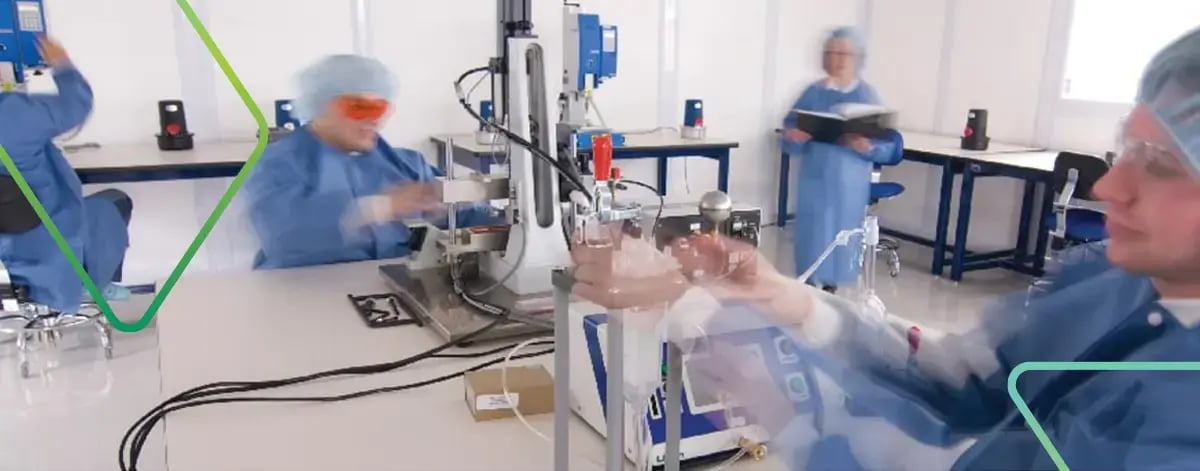6 min read
The Critical Manufacturing Step Most Medical Device Companies Skip - Processes Validation
 Bill Croisetiere
:
Nov 5, 2025 10:36:34 AM
Bill Croisetiere
:
Nov 5, 2025 10:36:34 AM

You've spent months perfecting your medical device concept. The prototype works beautifully in testing. Your team is energized, regulatory strategy is taking shape, and clinical trials are on the horizon. So why are seasoned manufacturing experts urging you to pump the brakes?
The answer lies in a critical but often underappreciated step that can make or break your transition from prototype to scalable manufacturing: medical device process validation.
At a Glance
- Process validation is the undervalued critical step between late-stage prototypes and successful clinical builds
- Most innovators think they can skip essential phases, jumping from concept development (Phase 1) straight to production (Phase 5)
- Three strategies for high-confidence process validation: start with the right specifications, know exactly what you're validating through risk analysis, and conduct robust cross-functional design reviews
- Timing matters: Investigate manufacturing processes before design freeze to make smarter investment decisions
- Reality check required: Accept where you are in your journey. True validation may require 5x more units than you'll make in your first five years
What Is Process Validation in Medical Device Manufacturing?
Process validation is the systematic approach to ensuring that a manufacturing process consistently produces medical devices that meet predetermined specifications and quality requirements. Unlike product testing, which verifies the final device, process validation ensures the manufacturing steps themselves are reliable and repeatable through the execution of Installation Qualification (IQ), Operational Qualification (OQ), and Performance Qualification (PQ) protocols.
The Problem: Medical Device Process Validation Doesn't Get the Attention It Deserves
When most people think about "design for manufacturability," they picture engineers in front of CAD systems, optimizing screw types and minimizing part counts. While that's certainly part of it, there's a more fundamental challenge lurking beneath the surface.
The real question isn't just whether your device can be manufactured. It's whether it can be manufactured consistently, reliably, and by anyone who follows your process. This distinction becomes critical when you consider that manufacturing hiccups don't just delay timelines; they can derail entire clinical programs.
Consider this real-world scenario: A micro-dosing syringe that worked perfectly when Paul assembled it on Monday but failed when Chris assembled identical units on Tuesday. Same specifications, same materials, same assembly instructions. The difference? The gluing and curing processes had never been properly specified, validated, or challenged. Success depended entirely on individual skill and intuition.
This is precisely the type of manufacturing vulnerability that medical device process validation is designed to eliminate.
Medical Device Development Phases: The Dangerous Gap from Prototype to Production
Most medical device development follows a structured phase-gate approach, moving through research and concept generation (Phase 0), concept development and feasibility (Phase 1), detailed design (Phase 2), design verification (Phase 3), design validation and manufacturing transfer (Phase 4), and finally production support (Phase 5).
Here's where things go wrong: Companies often leave Phase 1 thinking they're ready for Phase 5. They have a working prototype and assume manufacturing is simply a matter of making more of them. What they're missing are the critical phases 2-4, where the real work of manufacturing transfer happens.
This gap becomes expensive quickly. Process variation and process drift are real phenomena. You might manufacture good product one week and failing product the next, with no clear understanding of what changed. The root cause almost always traces back to what was or wasn't accomplished in those middle phases.

Three Pillars of High-Confidence Medical Device Process Validation
-
Start with the Right Specifications
Before you can validate any process, you need to know what "right" looks like. This means developing specifications that are not only technically sound but also manufacturing-friendly. Your specifications should account for real-world variability and provide clear pass/fail criteria that operators can consistently apply.
-
Know What You're Validating Through Rigorous Risk Analysis
Before investing time and resources in process validation, conduct thorough Failure Mode and Effects Analysis (FMEA) on both your design and your manufacturing processes. This systematic approach helps you identify where risks truly lie, both in your device design and in the processes used to make it.
Ask yourself: Have you analyzed your device thoroughly enough to understand where failure is most likely to occur when it's used in its intended environment? This analysis takes time, but it's essential for focusing your validation efforts where they'll have the most impact.
-
Implement Cross-Functional Design Reviews with Independent Eyes
We all become blind to our own work over time. Just as a writer needs an editor to catch errors they've read past dozens of times, your manufacturing processes need fresh, independent review from experts who haven't been living with your design decisions for months.
These reviews should include manufacturing engineers who can flag potential process difficulties before they become expensive problems. Comments like "those dimensions look really tight. Will we actually be able to assemble these consistently?" or "this assembly sequence is going to be brutal at scale" are exactly what you want to hear early, not after you've committed to tooling.
The Reality Check: Accept Where You Are
Here's the uncomfortable truth: if you're planning to manufacture only 2,000 units in your first five years, full process validation might require you to build 10,000 units just for validation purposes. The math doesn't work for many early-stage companies.
This doesn't mean you should skip process development entirely. Instead, you might choose to "inspect quality into the product" rather than validate it in, a riskier approach, but sometimes the only practical option given resource constraints.
The key is making this decision consciously, with full awareness of the trade-offs involved, rather than stumbling into it accidentally.
Don't Get Boxed In: Think Downstream
One final consideration: don't be afraid to optimize your design early if it prevents major manufacturing headaches later. For example, if your current design requires assembling five separate components into a subassembly, it might be worth the upfront investment to redesign that as a single injection-molded part.
These decisions become much more expensive to reverse after design freeze, which is why investigating your manufacturing processes before that milestone is so critical.
The Bottom Line
Process validation isn't glamorous, but it's the difference between a manufacturing process that scales smoothly and one that requires constant firefighting. The investment you make in understanding and validating your processes during phases 2-4 pays dividends when you're ready to scale production.
The companies that get this right don't need fully automated production lines right out of the gate. They need processes that are robust enough that anyone can execute them successfully. Automation can come later, once you understand exactly what you're automating.
Key Takeaways for Medical Device Process Validation
- Start early: Investigate manufacturing processes before design freeze to avoid costly changes later
- Focus on consistency: Your goal is repeatability, not just functionality
- Balance risk and resources: Accept where you are while planning for where you need to be
- Think systematically: Use FMEA and cross-functional reviews to identify risks before they become problems
Frequently Asked Questions
When should medical device process validation occur? Process validation activities should begin during Phase 2 (detailed design development) and continue through Phase 4 (design validation and manufacturing transfer). The earlier you start, the more flexibility you have to optimize both design and process.
How much does medical device process validation cost? Costs vary significantly based on device complexity, but expect to invest 15-30% of your development budget in phases 2-4. This upfront investment typically saves 3-5x that amount in avoided manufacturing issues and delays.
What's the difference between design validation and process validation? Design validation confirms your device works as intended for users. Process validation ensures your manufacturing process consistently produces devices that meet specifications. Both are required for regulatory approval.
What happens if you skip process validation? Companies that skip process validation often experience inconsistent product quality, failed clinical trials due to device failures, expensive manufacturing troubleshooting, and delays in regulatory approval and market launch.
Related Reading: Building a Resilient Medical Device Supply Chain: Your Action Plan for Success
For medical device companies navigating today's complex manufacturing landscape, your medical device supply chain can make or break your path to market. Whether you're preparing for clinical builds or scaling to meet market demand, the actions you take today to evaluate and collaborate with suppliers directly impacts your regulatory success, product quality, commercial success and operational resilience tomorrow.
Ready to dig deeper into process validation for your medical device?
The manufacturing services experts at Veranex have guided hundreds of medical device companies through this critical transition. Whether you're wrestling with specifications, risk analysis, or manufacturing transfer strategy, experienced guidance can help you avoid costly missteps and accelerate your path to market. Learn more about our medical device contract manufacturing services or reach out to start a conversation about your specific manufacturing challenges.
About the author
Bill Croisetiere serves as Senior Director, Integrated Supply Chain & Operations at Veranex, bringing 34 years of extensive global experience and a profound internal drive for delivering successful results that align with client interests. His distinguished career, including two decades at Covidien, spans diverse management roles across manufacturing operations, supply chain, engineering, program management, IT, sales, and business development within global and private medical device, pharmaceutical, molding, and technology companies.
Based in Providence, Bill is a seasoned expert in critical areas such as manufacturing processes, sustaining and value engineering, product identification (UDI), advanced packaging systems, ERP implementation, and RF warehouse management solutions. This rich, multifaceted background provides him with a unique perspective to thoroughly analyze client needs. He excels at aligning business models with commercial and financial goals, ensuring that Veranex’s integrated supply chain strategies are optimized to support innovative product development and engineering projects from concept through to commercialization. His PMP and CSCP certifications further underscore his commitment to excellence in program and supply chain management.



